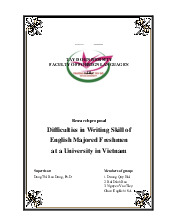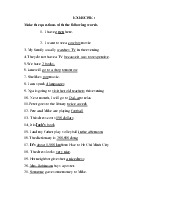







Preview text:
TABLE OF CONTENTS
TOPIC : COMPARISON OF CHILD MARRIAGES AND LATE MARRIAGE THE
CURRENT POLICY OF VIETNAM FOR BOTH OF IT .................................................... 3
I Introduction ........................................................................................................................... 4
II Body ....................................................................................................................................... 5
2.1 Child marriage ................................................................................................................ 5
2.1.1. What is child marriage? ........................................................................................... 5
2.1.2. Consequences of child marriage ............................................................................. 5
2.2. Late marriage ................................................................................................................. 5
2.2.1. What is late marriage? ............................................................................................. 5
2.2.2. Consequences of late marriage ................................................................................ 5
3. Compare ............................................................................................................................ 6
III. Vietnam's policy ................................................................................................................. 7
V. Conclution ............................................................................................................................. 8
TOPIC : COMPARISON OF CHILD MARRIAGES AND LATE MARRIAGE
THE CURRENT POLICY OF VIETNAM FOR BOTH OF IT
Child marriage and early marriage are two different types of marriage, with
opposite impacts on population structure and social life. Child marriage refers to a
union in which one or both parties are under the age of 18, while late marriage is
characterized by individuals marrying at an older age. Child marriage is common
globally, with one in five girls married before the age of 18. This practice hinders
children's educational opportunities and has potentially serious and dangerous health
consequences. risk of domestic violence.
On the contrary, late marriage has become common globally and has an important
impact on population structure and long-term social consequences. Late marriage often
leads to delays in having children, contributing to reduced birth rates and an aging
population. These population changes can affect social welfare systems, labor markets and overall social dynamics.
In the Vietnamese context, the Government has recognized the negative impacts of
child marriage and implemented policies and measures to combat this situation. There
have been many efforts to raise awareness of the negative consequences associated
with child marriage and to provide support for children at risk. The government is also
focused on promoting access to education and empowering young girls to make
informed decisions about their future.
Regarding late marriage, Vietnam's current policy may change depending on specific
demographic challenges and social needs. Policies to encourage late marriage could
include initiatives such as financial incentives for couples to delay marriage and
childbearing, promoting family planning services, and supporting opportunities
develop. Professional development for individuals.
In summary, child marriage and child marriage have opposite impacts on population
structure and social life. While child marriage poses significant challenges to
education, health and safety, child marriage can affect population dynamics and have
long-term consequences for society. Vietnamese policy prioritizes addressing the issue
of child marriage, and there may be different approaches to supporting late marriage
based on specific demographic factors.
Key wrods : Child marriage, late marriage
I. Introduction :
Child marriage and late marriage represent two contrasting trends in the field of
marriage. Child marriage is a serious global issue, with one in five girls getting
married before the age of 18. This reality not only robs children of their childhood but
also hinders their educational opportunities. The health consequences are also
significant, as young brides face high risks related to early pregnancy and childbirth.
Furthermore, child marriage leads to increased domestic violence, perpetuating a cycle of violence and inequality.
On the other hand, late marriage is becoming increasingly common and has profound
effects on population structure and social dynamics. As people delay marriage to focus
on education, career development, and personal growth, the average age of marriage is
rising. While late marriage brings benefits such as higher education attainment and
financial stability, it also poses challenges in terms of declining birth rates and an
aging population. This can put pressure on retirement systems and impact the ability to provide a young workforce.
Vietnam, like many other countries, is facing both of these challenges. The
government has implemented measures to eliminate child marriage and address the
consequences of late marriage. Increasing awareness of the negative impacts of child
marriage, improving access to education, and enforcing legal frameworks to protect
children's rights are crucial steps. For late marriage, the government needs to develop
policies to cope with changing population structures and ensure the sustainability of
social welfare systems in the face of an aging population. Vietnam is striving to build a
society that protects the rights and development of its citizens while ensuring
sustainable social development. Addressing both child marriage and late marriage is an
important part of achieving this goal. II. Body : 2.1 Child marriage.
2.1.1. What is child marriage?
Child marriage is the practice of getting married when one or both parties are not
of legal age for marriage. One in five girls is married before the age of 18 and child
marriage deprives children of education, can lead to serious health consequences and
increases the risk of violence.
For example: "H is 16 years old and P is 15 years old. When the two children were at
the age where they should have gone to school, their parents forced them to get
married, abandon their studies and take care of their lives." Living to make a living,
the burden of food, clothing and money falls directly on their shoulders."
2.1.2. Consequences of child marriage.
2.1.2.1. Lack of education.
Early marriage will cause children to lack education and lack understanding of
social and economic knowledge. If there are more and more elements of child
marriage in society, it will cause the country to deteriorate further and affect the children's future.
2.1.2.2. Health risks.
Child marriage will cause psychological stress on both parties. Child marriage
will lead to early childbirth, which causes children's health to deteriorate further and
can lead to serious psychological effects. There is a risk of death in cases of giving birth at a young age. 2.2. Late marriage.
2.2.1. What is late marriage?
Late marriage is marriage after middle age. Late marriage is now becoming
popular globally, affecting population structure and can cause long-term consequences for social life.
2.2.2. Consequences of late marriage.
2.2.2.1. Reduce birth rate.
Late marriage can limit the time it takes to have children, because as
reproductive health declines with increasing age, having children becomes more difficult for women.
2.2.2.2. Aging population.
The aging of the population is an important problem in modern society and late-
life employment affects this situation. Marital outcomes are often associated with low
childbearing and lower fertility rates. As people look forward to getting married and
having children when they are older, the proportion of elderly people increases and the
number of newborns decreases. This leads to demographic imbalance, creating a
society with a high proportion of elderly people and an insufficient number of children. 3. Compare.
Child marriage and late marriage represent two opposing aspects of marriage in
modern society. Child marriage, originating from traditional societies, represents early
marriage at a young age and the main goal is to maintain the family line and strengthen
family ties. In contrast, late marriage reflects the tendency to marry at an older age,
after achieving personal and professional stability.
Child marriage often occurs in environments with an extended family culture, where
early marriage is considered a tradition and social norm. Children and adolescents are
often married at the discretion of their families and do not have free choice in choosing
a partner. While child marriage can maintain traditional family bonds, it sometimes
hinders the freedom and personal development of the parties in the relationship.
In contrast to early marriage, late marriage often focuses on freedom of choice and
personal development. People who get married late often decide to build financial
stability and career before deciding to get married. They can enjoy their independence
and seek compatibility and consensus in a relationship before making a long-term
commitment. Late marriage also shows the tendency to delay childbearing, affecting
the population and posing a challenge to the social welfare system.
Despite the differences, both early marriage and late marriage reflect changes in the
concept of marriage and family in modern society. Choosing when and with whom to
marry is a personal freedom and reflects an individual's values and priorities. Most
importantly, both concepts contribute to diversity and create unique challenges and
consequences in societies and populations.
III. Vietnam's policy :
Regarding child marriage: Our government has issued laws to reduce child
marriage. At the same time, we also propagate and mobilize people (especially
highland people) about child marriage. Encourage education for children. Mobilizing
finances for families with difficult conditions to access education and be more aware of child marriage
As for late marriage: The State has encouraged some support contents: Encourage men
and women to get married before 30 years old, not to marry late and give birth early,
women to give birth to their second child before 35 years old; Building an
environment and community suitable for families raising children; Support women
during pregnancy and childbirth; Support and encourage couples IV. Personal.
Comparing child marriage and late marriage gives me an overview of two
important issues in society. Child marriage will cause serious negative impacts on the
health and development of children because they are underage, while late marriage can
cause pressure and limit personal freedom. The fact that the Vietnamese government
has introduced policies to address both of these issues is an important step. Through
research, I appreciate that Vietnam passed the Law on Marriage and Family in 2014 to
limit child marriage. This demonstrates the government's concern and commitment to
protecting children from the negative impacts of child marriage. However, to achieve
maximum effectiveness, enforcement and monitoring of compliance with this
regulation remains a challenge in highland areas. And for late marriage, I think that
encouraging delaying marriage until adulthood is right and necessary. This allows
individuals time to develop themselves in completing their education and better prepare for family life.
While Vietnam's current policy has achieved some progress, I think there needs to be
further strengthening of policy enforcement and public propaganda to further raise
awareness and change social attitudes. . At the same time, ensuring compliance with
regulations on child marriage and late marriage should be given a higher priority to
protect the rights and development of young individuals. And finally, I hope that
Vietnam will continue its efforts in preventing child marriage and encouraging safe
and healthy late marriage. Only through these efforts can we build an equitable and
developed society, where the rights and potential of every individual are respected and protected. V. Conclution :
Vietnam's current policies on both issues, shows the Government's sensitivity
and concern in protecting rights and interests. personal development, especially
children. Regarding the issue of late marriage, the Vietnamese Government has
recognized the importance of preparing well for family life by delaying marriage until
adulthood. Propaganda and education work on the benefits of getting married after the
age of 18 is implemented to change society's perceptions, encouraging individuals to
delay marriage to have opportunities for personal development.
Regarding the issue of child marriage, the Vietnamese Government recognizes the
importance of preparing for family life by delaying marriage until adulthood. Carry
out propaganda and education about the benefits of getting married after 18 years old,
change social concepts, and encourage individuals to get married early to have
opportunities for personal development. However, to ensure the effectiveness of the
policy, it is necessary to further strengthen monitoring of implementation and
compliance with regulations on children. Educational efforts also need to be expanded
and focused on these two issues to raise awareness and change social attitudes. By
promoting safe, healthy child marriage, Vietnam can continue to make progress in
protecting the rights and development of young people and building a just and progressive society. REFERENCE
1. Minh. H (2023, November 18). Khuyến khích nam, nữ kết hôn và sinh con sớm:
Trước khi phản đối, hãy lắng nghe. Báo Pháp Luật Việt Nam Điện Tử.
https://baophapluat.vn/khuyen-khich-nam-nu-ket-hon-va-sinh-con-som-truoc-khi-
phan-doi-hay-lang-nghe-post495882.html?
fbclid=IwAR0f11LjfH2n6DyizKAaW_SEaIIZjjguqucUdz1_8c2JGtY4afzpiR8ZoqI.
2. Linh. P (2023, Octorber 20). Một số thông tin cần biết về tảo hôn và hôn nhân cận
huyết thống. https://tuyenquang.dcs.vn/DetailView/145244/36/Mot-so-thong-tin-can-
biet-ve-tao-hon-va-hon-nhan-can-huyet-thong.html?
fbclid=IwAR0Hc_nRel4fjbewrVIuX4T9_mayzLnAOWrPlkEJBrWqB8J_aGsz_Q2ES
ak#:~:text=%C4%90%E1%BB%91i%20v%E1%BB%9Bi%20h%C3%A0nh%20vi
%20t%E1%BA%A3o,ch%C6%B0a%20%C4%91%E1%BB%A7%20tu%E1%BB
%95i%20k%E1%BA%BFt%20h%C3%B4n.
3. Digital V. (2023, June 23). Khi người trẻ lựa chọn kết hôn muộn. https://vtv.vn/xa-
hoi/khi-nguoi-tre-lua-chon-ket-hon-muon-20230623115619863.htm?
fbclid=IwAR0q9aVZ1PbsOHLxhjMOFIpvVrCj-5Dzzzaa-pqQX-
qDLzEdROtchz58g0g#:~:text=Ng%C6%B0%E1%BB%9Di%20tr%E1%BA%BB
%20v%C3%A0%20l%C3%BD%20do,n%C3%B3i%20v%E1%BB%81%20chuy
%E1%BB%87n%20k%E1%BA%BFt%20h%C3%B4n.
4. My. D (2021, May 3). Các giải pháp nhằm giảm thiểu tình trạng tảo hôn và hôn nhân
cận huyết thống. https://soctrang.gov.vn/Default.aspx?
sname=huyenchauthanh&sid=1308&pageid=33327&catid=57716&id=326306&catna
me=Tin-Giao-duc---Y-te&title=Cac-giai-phap-nham-giam-thieu-tinh-trang-tao-hon- va-hon-nhan--can-huyet-
thong&fbclid=IwAR2aBbffoot0vNHeWh0O4rFrnEg0B9d0ZkSsRQdVAOmnMZcICJ 3StLQaT34.




